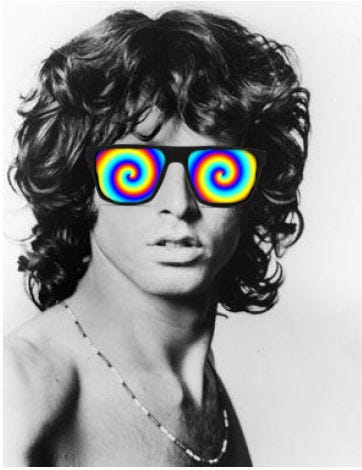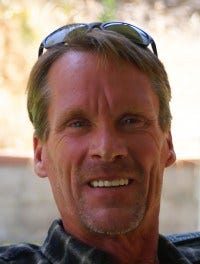Books Your Parents Warned You About: Weird Scenes Inside the Canyon
David McGowan's final book examines hippies, mind-control and the music of the 1960s
Well, I hear that Laurel Canyon is full of famous stars,
But I hate them worse than lepers and I'll kill them in their cars.
Neil Young, Revolution Blues
Weird Scenes Inside the Canyon: Laurel Canyon, Covert Ops & the Dark Heart of the Hippie Dream by David McGowan documents the strange alchemy present in Laurel Canyon—a narrow strip of rocky land just north of Los Angeles.
In the mid-1960s, the desolate area of southern California held little that would appeal to a rock’n’roll musician; nevertheless, it quickly became the unlikely mecca for a new wave of rebellious artists. This ‘unplanned’ assembly produced a large number of influencers for the decade’s coming culture revolution. Many of the bands went on to become wildly popular and their music influenced a generation of young people to ‘turn on, tune in, and drop out.’
Laurel Canyon performers acted as de facto mouthpieces for the protest-generation, with songs espousing anti-war attitudes and lyrics that helped usher in a fresh set of values. Their social messages were often muffled beneath loud clothes, free love and boisterous drug use—tools that arguably distracted America’s youth in the 60s more than they focused them on enacting societal changes.
These circumstances lead author Dave McGowan to question the authenticity of the ‘hippie movement’ developing between the Canyon’s walls. Was it truly the result of a random series of organic events; or was there a sinister element orchestrating the scene from the shadows? The book explores the latter idea, suggesting that the emerging counterculture of the 1960s was a coordinated psychological experiment designed to manipulate public opinion.
McGowan starts by digging into the backgrounds of Laurel Canyon’s famous musical residents. He reveals that a staggering number of the “most prominent members” had parents with ties to U.S. military or intelligence communities. Notable names include: Jim Morrison; Frank Zappa; Joni Mitchell; John Phillips of the Mamas and the Papas; David Crosby and Stephen Stills of Crosby, Stills & Nash; along with members of the Eagles and the Byrds.
These future rock’n’roll icons all arrived in the remote region “near simultaneously” in the mid-1960s. Their sudden appearance is puzzling, and McGowan struggles to pinpoint a motive for the congregation, noting “there was no music industry in Los Angeles… no live music scene to speak of... no discernible reason” to move there.
What siren’s call echoed through the walls of Laurel Canyon to attract such a large group of counterculture vanguards? As Canyon-dweller Neil Young recounted, they “were coming like lemmings.” Why?
McGowan has a theory. It involves members of the intelligence community and an attempt to socially engineer a generation of Americans. He argues that the ‘hippie crowd’ was deliberately manufactured to serve as controlled opposition and a conduit for large-scale mind control operation. Using anti-war celebrities and singers as puppets, government agents with a vested interest in the war-industry could dictate the ‘other side’s’ talking points. By infiltrating popular culture, they could leverage music and film to promote specific behaviors and attitudes to a captive audience. The mantra of ‘Sex, Drugs, and Rock’n’Roll’ became a way to placate a Sixties Generation on the precipice of social upheaval.
Instead of advocating for armed revolution as a way to change policies or laws they didn’t agree with, Laurel Canyonites preached from the hippie-gospel of peace, love and passive resistance.
They favored sit-ins over shoot-outs.
The book spotlights Jim Morrison, lead singer of The Doors, as a prototypical example of the ‘formula’ used to spawn the 1960’s counterculture. Practically overnight, young Morrison morphed from a short-haired, clean-cut youth with zero musical experience into a drug-fueled rock’n’roll idol with his own accompanying band. One former member even went so far as to say that the freshly-minted flower-child “embodied hippie counterculture rebellion.”
Apparently, Morrison was a quick learner.
Curiously, Jim’s father wasn’t simply the progenitor of a ‘Rock god,’ he was also an admiral in the United States Navy, and a commanding officer involved in the infamous 1964 Gulf of Tonkin Incident (a suspected ‘false-flag’ event that paved the way for the U.S. to enter into an unpopular Vietnam War).
According to McGowan, “while (Morrison’s) father is actively conspiring to fabricate an incident that will be used to massively accelerate an illegal war, the son is positioning himself to become an icon of the ‘hippie’ / anti-war crowd.” In order to avoid disclosing his inconvenient relation to a high-ranking member of the armed forces, Jim often told reporters that his father was dead.
During his legendary music career, Morrison mastered little more than a tambourine and a microphone, claiming that a majority of his song’s lyrics were composed during the course of a summer spent tripping on LSD. This anecdote provides the perfect cover story to explain how he became such a prolific songwriter in the span of only a few months.
McGowan questions how a straight-laced military- brat with no musical pedigree was able to coax together a band and “arrive on the scene as a fully formed entity.” He implicates The Doors as part of the conspiracy, assigning their instant fame to the intelligence community’s psychological operation.
Following a similar path to Laurel Canyon was another influential artist on the forefront of the hippie movement: Frank Zappa. Frank’s father also worked for the military—serving as a chemical warfare specialist at Edgewood Arsenal in Maryland. Coincidentally, Edgewood also happens to be the official headquarters for many of the government’s MK-ULTRA mind control experiments. Zappa later materialized in Laurel Canyon in the late-1960s without having any compelling reason to do so. By highlighting these connections, McGowan implies that Zappa could be a product of these psychological experiments—a Manchurian candidate programmed as a child and activated in his 20s.
Adding a cherry to the top of the synchronicity sundae is Frank’s wife, Gail, who also hailed from a military family. Funny enough, she happened to cross paths at a young age with fellow future hippie, Jim Morrison—they both attended the same Naval kindergarten class before reuniting decades later in Laurel Canyon. McGowan finds these facts unsettling, describing the series of events as “too many coincidences… to be a chance gathering.”
This is emblematic of McGowan’s research style. He has a gift for identifying patterns between people, places and events that are largely overlooked, obfuscated, or written off by the mainstream narrative.
The propensity for Canyon-dwellers to avoid the military draft at the height of the war; the surprising number of music clubs that opened ‘just in time’ to popularize and publicize marginally-talented Laurel Canyon artists; or the mysterious and grisly deaths plaguing many of the musicians’ circles may seem like chance sequences or unrelated coincidences—but to McGowan they are worthy of documenting and examining. The central question of his book becomes a rhetorical one: “How many coincidences does it take to make a conspiracy?”
One downside of the book is the cursory treatment given to a key element of the alleged scheme—namely, how did these bands and their music influence the masses? Were subliminal messages used? Brainwashing? Reverse speech?
McGowan does thorough work identifying the troops enlisted in the CIA’s musical army—including their supposed marching orders. He fails, however, to divulge their battle plans or tactics. The presence of a military film production studio nestled high above the Canyon on a peak named ‘Lookout Mountain’ begs a further discussion about the covert deployment of propaganda through media. Unfortunately, McGowan’s book pulls on none of these threads and leaves a significant part of the conspiracy unexplored.
Weird Scenes initially began as a series of blog posts from 2008-2012, giving the author a forum to document his research in real-time. In April 2014, two years after his last installment, McGowan excitedly announced an update to the Laurel Canyon saga: it was slated to be compiled into a book with additional content. In promotional interviews for the release, he sounded enthusiastic about its prospects and humbled by his newfound celebrity.
A year later, things were drastically different. McGowan took to his website in 2015 to share a heartbreaking statement about his unexpectedly deteriorating health. He’d been diagnosed with an aggressive and fatal form of cancer. His prognosis was dire and despite expressing hope that he’d “continue to expose the crimes of the elite for many years to come,” he passed away five months later at the age of 55.
After spending his life writing conspiracy literature, Dave McGowan’s death was haunted by conspiracy theories. Questions about the true nature of his untimely passing quickly circulated. It all seemed ‘too coincidental’ to be a random occurrence. He had a rich history of detailing secret plots by criminal elements within the world’s power structure—an inherently risky undertaking. This led some fans to speculate that he was somehow secretly infected with the incurable form of cancer that ended his life as a way to silence his research.
Contributing to the mystery was an ominous online comment that was posted months prior to Dave’s cancer diagnosis: “... this David McGowan fella really ought to quit smoking. With all the elitist feathers he’s ruffling, he’s likely to come down with a spontaneous case of hitherto undiagnosed stage 4 inoperable Pancreatic cancer.”
A true conspiracy-archivist to the end, McGowan chose to highlight this morbid synchronicity in one of his last messages to loyal supporters.
Was the counterculture a carefully constructed PsyOp curated by “intelligence operatives posing as entertainers”—or were the standard-bearers of hippie-dom authentic? Perhaps it was a mixture of both, an alchemy requiring a combination of natural and artificial ingredients. McGowan even hints at a more sinister reason for manufacturing the Laurel Canyon alumni. Theories involving Charles Manson, ritualistic murders and the sudden proliferation of brutal serial killers concurrently across the country add dark undertones to the folksy melodies reverberating out of southern California. (For a robust discussion regarding the strange circumstances surrounding many of the country’s serial killers and their origins, check out Dave McGowan’s earlier book, ‘Programmed to Kill.’)
Despite lingering mysteries, one thing is certain about the music of Laurel Canyon—it carries the power to inspire and impact listeners decades after its creation.














I find a lot if the book to be BS. A lot of it seems to be based on rumor and conjecture. Mr. McGowan seemed to be obsessed with Manson, and seemingly all these people seem to have a connection to Manson. Like Wilson. They have denied their involvement in supporting Manson's music
Its a good read, but many points are exaggerated.
Example: Frank Zappa/Mix Cabin living room was supposedly 3000 sq feet, iirc, there are no pictures, or facts documenting this. Gram Parsons was involved with Emmylou Harris at the time of his death. This wasn't mentioned.
I like the book review but in no way were Morrison or Zappa unwitting Manchurian Musicians. The parents may have gotten their foot in the recording studio but I don't think you can induce musical talent with mind control